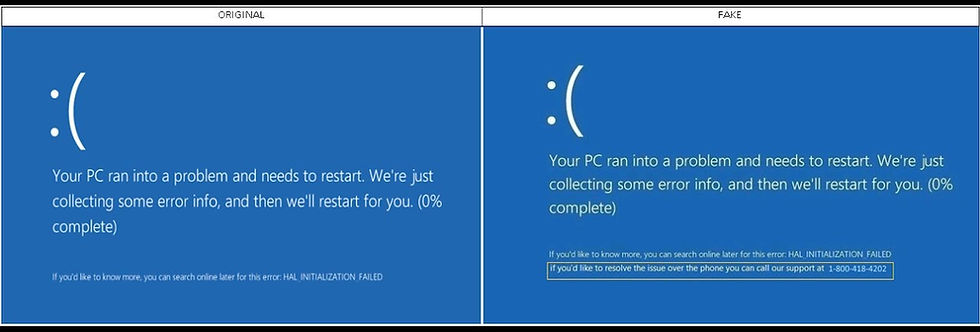Tech Support Scam Takes Over Your Whole Screen
- Paul Isaacson

- Aug 22, 2017
- 3 min read
Updated: Jul 14, 2022
Whether you use Microsoft Windows, Mac OSX or Android you may be presented with a new variant of Tech Support Scam. Unlike previous variants this error will appear on the entire screen with what seems no way to close it.

Scammers may call, place alarming pop-up messages on your computer, offer free “security scans”, or set up fake websites – all to convince you that your computer is infected. The scammers try to get you on the phone, offer to remote into your computer and then work to convince you there’s a problem. Finally, they ask you to pay them to fix that non-existent problem.
Tech Support Scams
To convince you that both the scammers and the problems are real, the scammers may:
pretend to be from a well-known company – like Microsoft or Apple
use lots of technical terms
ask you to get on your computer and open some files – and then tell you those files show a problem (when they don’t)
Then, once they’ve convinced you that your computer has a problem, the scammers might:
ask you to give them remote access to your computer – which lets them change your computer settings so your computer is vulnerable to attack
trick you into installing malware that gives them access to your computer and sensitive data, like user names and passwords
try to sell you software that’s worthless, or that you could get elsewhere for free
try to enroll you in a worthless computer maintenance or warranty program
ask for credit card information so they can bill you for phony services, or services you could get elsewhere for free
direct you to websites and ask you to enter your credit card number and other personal information
These scammers want to get your money, access to your computer, or both. But there are things you can do to stop them.

If You Get a Call or Pop-Up
If you get an unexpected or urgent call from someone who claims to be tech support, hang up. It’s not a real call. And don’t rely on caller ID to prove who a caller is. Criminals can make caller ID seem like they’re calling from a legitimate company or a local number.
If you get a pop-up message that tells you to call tech support, ignore it. There are legitimate pop-ups from your security software to do things like update your operating system. But do not call a number that pops up on your screen in a warning about a computer problem.
If you’re concerned about your computer, call a reputable and local computer repair company or technician directly – but don’t use the phone number in the pop-up or on caller ID. Instead, look for the company’s contact information online, or on a software package or your receipt.
Never share passwords or give control of your computer to anyone who contacts you.

If You Were Scammed
Get rid of malware. Update or download legitimate security software and scan your computer. Delete anything the software says is a problem.
Change any passwords that you shared with someone. Change the passwords on every account that uses passwords you shared. Change passwords for websites you have User Name and Passwords saved in your web browser.
If you paid for bogus services with a credit card, call your credit card company and ask to reverse the charges. Check your statements for any charges you didn’t make, and ask to reverse those, too. You can even file a report with www.ftc.gov/complaint.
Refund Scams
If you paid for tech support services, and you later get a call about a refund, that call is probably also a scam. Don’t give the person any personal or financial information.
The refund scam works like this:
Several months after a purchase, someone calls to ask if you were happy with the service.
If you say “No”, the scammer offers a refund.
Or, the caller says the company is going out of business and giving refunds.
The scammer eventually asks for your bank or credit card account number, or asks for access to your bank account to make a deposit. But instead of putting money in your account, the scammer takes money from your account.


